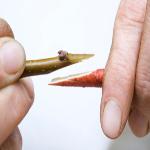This is the VOA Special English Agriculture Report.
这里是美国之音慢速英语农业报道。
Grafting is a way to produce plants from pieces of existing plants instead of seeds.
嫁接是一种从现存植物,而不是从种子繁殖植物的方法。
Branches or buds are cut from one plant and placed on a related kind of plant. The branch or bud that is grafted is called the scion. The plant that accepts the graft is called the rootstock.
从一种植物切下来的枝或芽被嫁接到另一种相近植物上。嫁接上去的枝或芽被称为接穗。被嫁接的植物体被称为砧木。
Grafting can join scions with desirable qualities to rootstock that is strong and resists disease and insects.
嫁接可以将优良性状的接穗与强壮、抗病虫害的砧木相结合。
A graft can be cut several ways. One way is a cleft graft. It requires a scion with several buds on it. The bottom of the scion is cut in the shape of the letter V.
嫁接有数种方法。其中一种是劈接法。接穗要长有数颗芽,底部削成双面楔形。
The scion is then securely placed into a cut on the rootstock. Material called a growth medium is put on the joint to keep it from getting dry and to help the two plants grow together.
然后将接穗插入砧木切口紧密贴合。将生长培养基敷在接口上,以保持湿润同时促进这两种植物长合。
Many fruits and nuts have been improved through grafting. Flowers can also be improved this way.
许多水果和坚果已通过嫁接改良。花卉也可以通过这种方式改良。
Some common fruit trees such as sweet cherries and McIntosh apples have to be grafted. Grafting is also used to produce seedless fruits like navel oranges and seedless watermelons.
一些常见的水果,例如甜樱桃和麦金托什苹果(注1)都需要嫁接。嫁接还能用于繁殖无籽水果,例如脐橙(注2)和无籽西瓜。
Grafting continues to hold an important place in agriculture even in an age of modern genetic engineering.
嫁接在农业中,即使在现代基因工程时代仍继续占有重要地位。
Recently we told you about a study of genetically engineered crops and how they have affected farming in the United States. The study found that many farmers have better harvests, better weed control and fewer losses from insect damage compared to traditional crops.
最近我们曾报道关于一项转基因作物的研究及它们如何影响美国农业。研究发现,相对于传统作物,许多(种植转基因作物的)农民收成更好,除草更容易,病虫害损失更小。(注3)
Our story brought a number of comments, including this one from Odalberto Domingos Casonatto in Brazil. He wrote that in his town the population depends on agriculture and transgenic crops. He says it is true that such crops can have higher output with less cost, but added:
我们的报道引来了一些评论,来自巴西的Odalberto Domingos Casonatto(巴西人名)写道,他所在的城镇的人们依赖于农业和转基因作物。他称,这类作物的确能够以较少的投入获得较高的产出,但他补充说:
No one knows the consequences that will have on soil fertility and the human body. Only the future will tell us the truth about transgenic food.
没有人知道(转基因作物)对土壤肥力和人体将产生什么样的后果。只有时间才能告诉我们转基因食品的真相。
Christian in France expressed a different concern, saying: The big problem of the transgenic seeds is that they are the monopoly of big companies. The small farmers cannot reproduce any more seeds by themselves.
法国的克里斯琴(Christian)表达了不同的担忧,他说:转基因种子的最大问题是由大公司垄断,小农户无法自己制种。
And Joom from Thailand wrote: I don't care where the crops come from, natural plants or genetic engineering, as long as we can produce food enough for people.
来自泰国和Joom说:我不在乎农作物到底是来自天然植物还是基因工程,只要能为人类生产足够的食物。
注1:麦金托什苹果:美国人麦金托什培育的一种晚熟的红苹果
注2:脐橙无籽,无法靠种子繁殖,只能嫁接。
注3:请查看之前报道Transgenic Crops Get Good Marks in General in US Study










